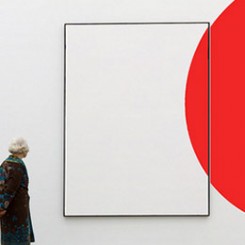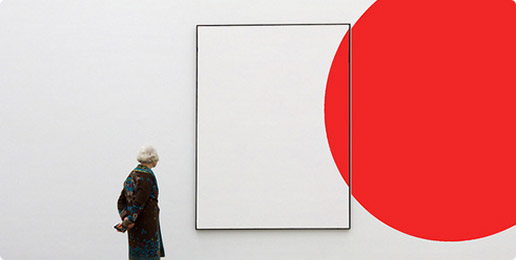This piece is included in Ran Dian’s print magazine, issue 3 (Spring 2016)
This is the story of something that happened to me when I was at art school—a small incident that remains vivid to me even now. It is about the process of viewing art exhibitions.
A gallery owner took me and a group of officials from the Ministry of Culture to see an artist’s exhibition. There, the artist carefully explained the allusions and metaphors embedded in each work, how they were connected and how they played off one another. The way the artist described his vision, the concepts he was subverting and reconstructing, and how he had interwoven allusions to other classics was fascinating. He made his points clearly and with sound logic, and he had an engaging way of talking about his art that I found mesmerizing. I was thoroughly enjoying myself when I had a sudden, rude awakening. The Ministry of Culture officials had been smiling and nodding throughout the entire tour, but at this point, a middle-aged female official spoke up and said, “Yes, that is very creative.”
When this 5-word sentence came crashing into my consciousness, I was dumbfounded. I felt a bit embarrassed, slightly muddled, and several thoughts began clamoring for attention in my mind. At the time I wasn’t able to react, but I’ve inadvertently started thinking about it again recently, so I wanted to try to unpack and organize my thoughts:
1
Isn’t the phrase “that was very creative” more or less the same as saying “that was very interesting”? It is a phrase laden with meaning, gravid with skepticism and unexpressed opinion. With that one noncommittal sentence, spoken in her accented Mandarin, that Ministry official drained the seemingly bottomless well of cultural significance from the paintings. She then flung me into the parched desert where the holy spring of art had once flowed.
At the time I was just about to graduate, soon to join society and the greater art scene. I had no marketable skills and no knowledge to speak of. All I had to offer the world was a sincere devotion to art and a blurry road map to a so-called career in art. A sentence like that, spoken to an inexperienced, self-satisfied imitator such as myself, left me completely dejected before I was even on my way.
2.1
What is creativity? Creativity implies the urge to create or innovate. It points to the potential for new, abstract ideas or actions derived from an understanding and awareness of reality. Creativity is a method used to tap into and activate different resources, and can further enhance the value of a resource. Why am I so viscerally conflicted about this word? I don’t recall any of my professors or textbooks ever using the word creative in my study of art. We might have said something was “imaginative” or “well thought out”; we might have called someone “talented,” but we would never have said something was “very creative.”
2.2
Creativity gives me a sense of pause. A new creative idea often replaces an old one. A creative idea may be followed by a series of operations to be performed. We might try to explore an idea, but we rarely explore a creative approach in depth. Ideas seem to have depth and space for exploration, but creative inspiration more often inhabits a single point, and is used to trigger a different approach.
2.3
Creativity implies cleverness and usefulness, as if the word is a tool. Creativity lives in the same building as knowledge, sentiment, and taste, but it is cut off from its neighbors by several impenetrable walls. When “brainstorming,” creativity becomes even more of a means of traveling down the path of trial and error.
Why does the word creative make me anxious?
3.1
First, creativity is a basic requirement for a good artist. It may be the lowest barrier of entry there is, just as strategists have to be strategic and warriors must be brave. No artist attempts to produce a great work of art by relying solely on this lowest common denominator, just as nobody expects “minimum social security” to give them a life of luxury. This is why it would have been preferable if the Ministry official had responded in a way that showed a complete lack of understanding, or expressed disagreement on some point.
3.2
Second, in many of the art-adjacent industries, the word creativity is applied in odd situations with unlikely bedfellows. It has become a commodity in the commercial context of supply and demand. In corporations, there are “creatives” and “creative directors.” A business proposal might be criticized as “lacking an element of creativity.” A competitor’s idea might show a “higher level” of creativity. A team might “implement” a creative plan. Yet artists do not solely work for the sake of satisfying a market demand, and the meaning of art transcends supply and demand.
3.3
Creativity should serve a purpose. When we select a creative approach, it should be effective. The viewer must understand that creativity has no need for explanation or explication. Creativity is deployed in aid of expression; it is a tool to convey ideas, thought, and talent in a work of art. When creativity becomes the focus of art, it is like visiting the Sistine Chapel and spending the entire time marveling at the fixtures in the toilets.
In the Ice Bucket Challenge that was so popular a few years ago, the purpose of the challenge was not to make people cold, but to raise awareness of ALS. The ice and the bucket were the tools, and awareness was the goal. The creative idea behind the Ice Bucket Challenge brought greater awareness of the disease; it drew the attention of many who would not normally be interested in the disease because they wanted to see celebrities attempt the challenge.
Good artists are working within a similar context. They might have some element of greatness inside them, but unless it is effectively conveyed through their work that greatness will either be ignored or lost. When assessing whether a creative idea or concept is good or bad, the criteria should not have anything to do with the amount of attention it attracts, but whether it serves the subject. The same format may work for one topic, but be unsuited to another. A good creative idea will not shine without its purpose or subject. The Ice Bucket Challenge is not about conveying the symptoms of ALS. Rather, after participants have used the creativity of the challenge to draw the viewer’s attention, they leverage this attention to encourage awareness of what ALS is and how people can help.
More importantly, when there is more knowledge, thought, and talent behind a work of art, its creativity feels more intrinsic. Creativity can transform an anomalous, attention-seeking “peculiarity” into an intrinsic element of “rightness.” All great artworks are seamless in this way. This is why saying a work is “very creative” is a negation of the content behind the creativity. It misses the point.
Who, after speaking passionately and at great length about their achievements over the years, would be happy to hear an interviewer say, “Oh, you enunciate your words very clearly”!?
4
How do we find relief from embarrassment?
4.1 Confidence
Under different circumstances, for instance if the speaker hadn’t been going so deeply into the intricacies underlying his art, or if the Ministry officials were knowledgeable about the subject, then I believe a lively discussion would have followed the tour of the exhibition. However, in my anecdote, while the artist brought out the best he had to offer, the viewers did not have the capacity to digest any of it. As a result, the artist’s explanation was wasted, while the Ministry officials were embarrassed by their inability to appreciate their host’s effusiveness.
As writers we inevitably encounter such audiences. They did not pick up your writing to receive new information, but because they merely wanted to verify knowledge they already possessed. You might have something brilliant to say, but you have to bring them along for the ride. You cannot carry them; they must be in collusion with you. Otherwise they will be faced with an unenviable choice between pretention and ignorance. Though such audiences are not ideal, writers should not bemoan their existence. We must face audiences such as this and realize that they are struggling, too. They also want the best of everything, and we must remember that “growth” always involves some ache and some pain. Yet it is in this aching that artists find the greatest joy.
4.2 Belief in Art
[Abridged]
4.3 Self-Preservation
I believe that cultists and salespeople alike know how to protect themselves. They face much criticism and even hostility from the world, and they know how to transform negativity into positivity. At the moment I am reading about success and positive thinking, so I have some insight into this fascinating subject. I’d like to conclude with a strange and wonderful quote I found in one of these books: “No one who ever accomplished anything great ever got himself killed on the way to the supermarket.”


